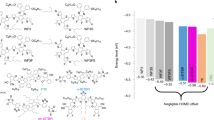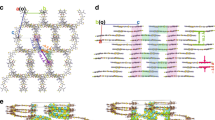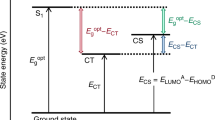Abstract
Recent advances in organic solar cells based on non-fullerene acceptors (NFAs) come with reduced non-radiative voltage losses (ΔVnr). Here we show that, in contrast to the energy-gap-law dependence observed in conventional donor:fullerene blends, the ΔVnr values in state-of-the-art donor:NFA organic solar cells show no correlation with the energies of charge-transfer electronic states at donor:acceptor interfaces. By combining temperature-dependent electroluminescence experiments and dynamic vibronic simulations, we provide a unified description of ΔVnr for both fullerene- and NFA-based devices. We highlight the critical role that the thermal population of local exciton states plays in low-ΔVnr systems. An important finding is that the photoluminescence yield of the pristine materials defines the lower limit of ΔVnr. We also demonstrate that the reduction in ΔVnr (for example, <0.2 V) can be obtained without sacrificing charge generation efficiency. Our work suggests designing donor and acceptor materials with high luminescence efficiency and complementary optical absorption bands extending into the near-infrared region.
This is a preview of subscription content, access via your institution
Access options
Access Nature and 54 other Nature Portfolio journals
Get Nature+, our best-value online-access subscription
$29.99 / 30 days
cancel any time
Subscribe to this journal
Receive 12 digital issues and online access to articles
$119.00 per year
only $9.92 per issue
Buy this article
- Purchase on Springer Link
- Instant access to full article PDF
Prices may be subject to local taxes which are calculated during checkout




Similar content being viewed by others
Data availability
The authors declare that all relevant data are included in the paper and its Supplementary Information.
Code availability
The codes used in this paper are deposited on GitHub (https://github.com/chenxiankai/three-state-abs-and-emission).
References
Best Research-Cell Efficiencies (National Renewable Energy Laboratory, 2020); https://www.nrel.gov/pv/assets/pdfs/best-research-cell-efficiencies.20200311.pdf
Liu, Q. et al. 18% Efficiency organic solar cells. Sci. Bull. 65, 272–275 (2020).
Zhang, M. et al. Single-layered organic photovoltaics with double cascading charge transport pathways: 18% efficiencies. Nat. Commun. 12, 309 (2021).
Hou, J., Inganäs, O., Friend, R. H. & Gao, F. Organic solar cells based on non-fullerene acceptors. Nat. Mater. 17, 119–128 (2018).
Menke, S. M., Ran, N. A., Bazan, G. C. & Friend, R. H. Understanding energy loss in organic solar cells: toward a new efficiency regime. Joule 2, 25–35 (2018).
Liu, X., Rand, B. P. & Forrest, S. R. Engineering charge-transfer states for efficient, low-energy-loss organic photovoltaics. Trends Chem. 1, 815–829 (2019).
Vandewal, K., Tvingstedt, K., Gadisa, A., Inganäs, O. & Manca, J. V. On the origin of the open-circuit voltage of polymer–fullerene solar cells. Nat. Mater. 8, 904–909 (2009).
Benduhn, J. et al. Intrinsic non-radiative voltage losses in fullerene-based organic solar cells. Nat. Energy 2, 17053 (2017).
Qian, D. et al. Design rules for minimizing voltage losses in high-efficiency organic solar cells. Nat. Mater. 17, 703–709 (2018).
Eisner, F. D. et al. Hybridization of local exciton and charge-transfer states reduces nonradiative voltage losses in organic solar cells. J. Am. Chem. Soc. 141, 6362–6374 (2019).
Ran, N. A. et al. Impact of interfacial molecular orientation on radiative recombination and charge generation efficiency. Nat. Commun. 8, 79 (2017).
Liu, X., Li, Y., Ding, K. & Forrest, S. Energy loss in organic photovoltaics: nonfullerene versus fullerene acceptors. Phys. Rev. Appl. 11, 024060 (2019).
Ran, N. A. et al. Harvesting the full potential of photons with organic solar cells. Adv. Mater. 28, 1482–1488 (2016).
Liu, S. et al. High-efficiency organic solar cells with low non-radiative recombination loss and low energetic disorder. Nat. Photon. 14, 300–305 (2020).
Green, M. A. Radiative efficiency of state-of-the-art photovoltaic cells. Prog. Photovolt. Res. Appl. 20, 472–476 (2012).
Stranks, S. D. Nonradiative losses in metal halide perovskites. ACS Energy Lett. 2, 1515–1525 (2017).
Kirchartz, T., Rau, U., Kurth, M., Mattheis, J. & Werner, J. H. Comparative study of electroluminescence from Cu(In,Ga)Se2 and Si solar cells. Thin Solid Films 515, 6238 (2007).
Rau, U. Reciprocity relation between photovoltaic quantum efficiency and electroluminescent emission of solar cells. Phys. Rev. B 76, 085303 (2007).
Englman, R. & Jortner, J. The energy gap law for radiationless transitions in large molecules. Mol. Phys. 18, 145–164 (1970).
Ullbrich, S. et al. Emissive and charge-generating donor–acceptor interfaces for organic optoelectronics with low voltage losses. Nat. Mater. 18, 459 (2019).
Cui, Y. et al. Single-junction organic photovoltaic cells with approaching 18% efficiency. Adv. Mater. 32, 1908205 (2020).
Baran, D. et al. Reduced voltage losses yield 10% efficient fullerene free organic solar cells with >1 V open circuit voltages. Energy Environ. Sci. 9, 3783–3793 (2016).
Ziffer, M. E. et al. Long-lived, non-geminate, radiative recombination of photogenerated charges in a polymer/small-molecule acceptor photovoltaic blend. J. Am. Chem. Soc. 140, 9996–10008 (2018).
Karuthedath, S. et al. Intrinsic efficiency limits in low-bandgap non-fullerene acceptor organic solar cells. Nat. Mater. 20, 78–384 (2020).
Faist, M. A. et al. Competition between the charge transfer state and the singlet states of donor or acceptor limiting the efficiency in polymer:fullerene solar cells. J. Am. Chem. Soc. 134, 685–692 (2012).
Coffey, D. C. et al. An optimal driving force for converting excitons into free carriers in excitonic solar cells. J. Phys. Chem. C 116, 8916 (2012).
Vandewal, K. Interfacial charge transfer states in condensed phase systems. Annu. Rev. Phys. Chem. 67, 113–133 (2016).
Rand, B. P., Burk, D. P. & Forrest, S. R. Offset energies at organic semiconductor heterojunctions and their influence on the open-circuit voltage of thin-film solar cells. Phys. Rev. B 75, 115327 (2007).
Chen, X.-K., Coropceanu, V. & Brédas, J.-L. Assessing the nature of the charge-transfer electronic states in organic solar cells. Nat. Commun. 9, 5295 (2018).
Bixon, M., Jortner, J. & Verhoeven, J. W. Lifetimes for radiative charge recombination in donor-acceptor molecules. J. Am. Chem. Soc. 116, 7349–7355 (1994).
Fu, Y.-T. et al. Structure and disorder in squaraine–C60 organic solar cells: a theoretical description of molecular packing and electronic coupling at the donor–acceptor interface. Adv. Funct. Mater. 24, 3790–3798 (2014).
Han, G., Guo, Y., Ma, X. & Yi, Y. Atomistic insight into donor/acceptor interfaces in high-efficiency nonfullerene organic solar cells. Sol. RRL 2, 1800190 (2018).
Zheng, Z., Tummala, N. R., Wang, T., Coropceanu, V. & Brédas, J.-L. Charge-transfer states at organic–organic interfaces: impact of static and dynamic disorders. Adv. Energy Mater. 9, 1803926 (2019).
Zheng, Z., Tummala, N. R., Fu, Y.-T., Coropceanu, V. & Brédas, J.-L. Charge-transfer states in organic solar cells: understanding the impact of polarization, delocalization, and disorder. ACS Appl. Mater. Interfaces 9, 18095 (2017).
Wang, T. & Brédas, J.-L. Organic solar cells based on non-fullerene small-molecule acceptors: impact of substituent position. Matter 2, 119–135 (2020).
Vollbrecht, J. et al. Quantifying the nongeminate recombination dynamics in nonfullerene bulk heterojunction organic solar cells. Adv. Energy Mater. 9, 1901438 (2019).
Reinhardt, J., Grein, M., Bühler, C., Schubert, M. & Würfel, U. Identifying the impact of surface recombination at electrodes in organic solar cells by means of electroluminescence and modeling. Adv. Energy Mater. 4, 1400081 (2014).
Panhans, M. et al. Molecular vibrations reduce the maximum achievable photovoltage in organic solar cells. Nat. Commun. 11, 1488 (2020).
Kirchartz, T., Kaienburg, P. & Baran, D. Figures of merit guiding research on organic solar cells. J. Phys. Chem. C 122, 5829–5843 (2018).
Coropceanu, V., Chen, X.-K., Wang, T., Zheng, Z. & Brédas, J.-L. Charge-transfer electronic states in organic solar cells. Nat. Rev. Mater. 4, 689 (2019).
Zampetti, A., Minotto, A. & Cacialli, F. Near-infrared (NIR) organic light-emitting diodes (OLEDs): challenges and opportunities. Adv. Funct. Mater. 29, 1807623 (2019).
Kim, D.-H. et al. High-efficiency electroluminescence and amplified spontaneous emission from a thermally activated delayed fluorescent near-infrared emitter. Nat. Photon. 12, 98–104 (2018).
Ai, X. et al. Efficient radical-based light-emitting diodes with doublet emission. Nature 563, 536–540 (2018).
Goushi, K., Yoshida, K., Sato, K. & Adachi, C. Organic light-emitting diodes employing efficient reverse intersystem crossing for triplet-to-singlet state conversion. Nat. Photon. 6, 253–258 (2012).
Miller, O. D., Yablonovitch, E. & Kurtz, S. R. Strong internal and external luminescence as solar cells approach the Shockley–Queisser limit. IEEE J. Photovolt. 2, 303–311 (2012).
Pazos-Outón, L. M. et al. Photon recycling in lead iodide perovskite solar cells. Science 351, 1430–1433 (2016).
Yablonovitch, E. Lead halides join the top optoelectronic league. Science 351, aaf4603 (2016).
Perdigón-Toro, L. et al. Barrierless free charge generation in the high-performance pm6:y6 bulk heterojunction non-fullerene solar cell. Adv. Mater. 32, 1906763 (2020).
Karki, A. et al. Understanding the high performance of over 15% efficiency in single-junction bulk heterojunction organic solar cells. Adv. Mater. 31, 1903868 (2019).
Zhong, Y. et al. Sub-picosecond charge-transfer at near-zero driving force in polymer:non-fullerene acceptor blends and bilayers. Nat. Commun. 11, 833 (2020).
Yao, H. et al. 14.7% Efficiency organic photovoltaic cells enabled by active materials with a large electrostatic potential difference. J. Am. Chem. Soc. 141, 7743–7750 (2019).
Hinrichsen, T. F. et al. Long-lived and disorder-free charge transfer states enable endothermic charge separation in efficient non-fullerene organic solar cells. Nat. Commun. 11, 5617 (2020).
Classen, A. et al. The role of exciton lifetime for charge generation in organic solar cells at negligible energy-level offsets. Nat. Energy 5, 711–719 (2020).
Shockley, W. & Queisser, H. J. Detailed balance limit of efficiency of p–n junction solar cells. J. Appl. Phys. 32, 510 (1961).
Cheng, P. & Yang, Y. Narrowing the band gap: the key to high-performance organic photovoltaics. Acc. Chem. Res. 53, 1218–1228 (2020).
Kahle, F.-J., Rudnick, A., Bässler, H. & Köhler, A. How to interpret absorption and fluorescence spectra of charge transfer states in an organic solar cell. Mater. Horiz. 5, 837–848 (2018).
Creutz, C., Newton, M. D. & Sutin, N. Metal–ligand and metal–metal coupling elements. J. Photochem. Photobiol. A 82, 47–59 (1994).
Xie, Y. et al. Assessing the energy offset at the electron donor/acceptor interface in organic solar cells through radiative efficiency measurements. Energy Environ. Sci. 12, 3556–3566 (2019).
Zhao, W. et al. Fullerene-free polymer solar cells with over 11% efficiency and excellent thermal stability. Adv. Mater. 28, 4734–4739 (2016).
Acknowledgements
We thank K. Vandewal (Hasselt University) for insightful discussions and H. Wu (South China University of Technology) for providing the EQEEL value in a Y11 neat film. The research in Linköping was supported by the Swedish Strategic Research Foundation through a Future Research Leader program to F.G. (FFL 18-0322), Swedish Research Council VR (grant nos. 2016-06146, 2018-06048 and 2019-00677), and the Swedish Government Strategic Research Area in Materials Science on Functional Materials at Linköping University (faculty grant no. SFO-Mat-LiU #2009-00971); the work at Arizona was funded by the Department of the Navy, Office of Naval Research, under award no. N00014-20-1-2110 and the University of Arizona. F.G. is a Wallenberg Academy Fellow and O.I. is a Wallenberg Academy Scholar.
Author information
Authors and Affiliations
Contributions
X.-K.C., D.Q., V.C., J.L.B. and F.G. conceived the project; X.-K.C. carried out all of the theoretical simulations. D.Q. developed new blends. D.Q. made the devices and conducted the spectroscopy measurements together with Y.W. T. K. and M.H. contributed to the measurements of the electroluminescence spectra. T.K., W.T., O.I., V.C., J.L.B. and F.G. contributed to the result analysis. D.Q. and J. Y. conducted the cyclic voltammetry measurements. H.Y., J.Y., M.Z., Y.Z., Y.L. and J.H. developed the donor and acceptor materials. Y.S. developed two of PBDT-TS1-based blends. X.-K.C., D.Q., V.C., J.L.B. and F.G. wrote the manuscript. F.G. supervised the project. All authors discussed the results and commented on the final manuscript.
Corresponding authors
Ethics declarations
Competing interests
The authors declare no competing interests.
Additional information
Peer review information Nature Energy thanks the anonymous reviewers for their contribution to the peer review of this work.
Publisher’s note Springer Nature remains neutral with regard to jurisdictional claims in published maps and institutional affiliations.
Supplementary information
Supplementary Information
Supplementary Figs. 1–17, Notes 1–8 and Tables 1–8.
Rights and permissions
About this article
Cite this article
Chen, XK., Qian, D., Wang, Y. et al. A unified description of non-radiative voltage losses in organic solar cells. Nat Energy 6, 799–806 (2021). https://doi.org/10.1038/s41560-021-00843-4
Received:
Accepted:
Published:
Issue Date:
DOI: https://doi.org/10.1038/s41560-021-00843-4
This article is cited by
-
On the role of asymmetric molecular geometry in high-performance organic solar cells
Nature Communications (2024)
-
Decreasing exciton dissociation rates for reduced voltage losses in organic solar cells
Nature Communications (2024)
-
Physical insights into non-fullerene organic photovoltaics
Nature Reviews Physics (2024)
-
Deuteration-enhanced neutron contrasts to probe amorphous domain sizes in organic photovoltaic bulk heterojunction films
Nature Communications (2024)
-
Highlights of mainstream solar cell efficiencies in 2023
Frontiers in Energy (2024)



